15 Types of Orange Spiders With Pictures and Identification (Including Orange and Black Spiders)

Orange spiders are relatively rare because only a few species of spiders have orange bodies and heads. The most common orange spider is the marbled orb-weaver with its bulbous orange abdomen and orange and black patterns. Other species of orange arachnids include the woodlouse spider, cross orb-weaver spider, and triangular spiders. There are also species of jumping spiders with orange and black bodies.
Noticing any kind of spider scurrying across your floor or lurking in a dark corner can be a terrifying experience. But spotting an orange spider could send you into a panic. You may think that the spider’s orange color is a sign it’s a venomous spider. Or you may be wondering how to identify the exact species of orange spider.
This article is a comprehensive guide to identifying the most common types of orange spiders. Descriptions and pictures of the orange eight-legged creatures will help you recognize the creepy crawlies.
Facts About Orange Spiders
Orange spiders—like all spiders—belong to the arthropod class Arachnida. With some types of orange spiders, both the male and female have distinct orange coloring or patterns. With other spider species, it’s just the male or female classified as an orange spider.
Orange spiders can come in various shades of orange, ranging from bright orange with marbled patterns to a dark, almost reddish-orange. In addition, some tiny jumping spiders have an orange abdomen and black cephalothorax—the characteristic fused head and thorax that all spiders have.
There is also a type of spider—Theridion grallator—that develops an orange abdomen after consuming certain insects.
All species of orange spiders spin a silky web. Like red and black widow spiders, some orange spiders spin tangle webs to catch prey. However, not all orange-colored cobweb spiders use their webs to catch prey. Instead, some orange and black funnel-web spiders spin webs to protect eggs, hide out of sight, or for transportation.
How to Identify Orange Spiders
Orange spiders have identifiable orange coloring or patterns on their bodies or legs. All orange spiders are identified by having four pairs of legs, a body with two segments—cephalothorax and abdomen—and eight eyes. Orange spider identification is also possible by looking at the abdomen’s shape, size, and orangey patterns.
It is easy to tell the difference between orange spiders and insects. All spiders are identified by having eight legs attached to the cephalothorax. Spiders also lack wings, but they can jump, crawl, and inject venom to paralyze their prey. On the other hand, insects have six legs, and many insects have wings.
Types of Orange Spiders (with Pictures) – Identification Guide
Let’s look at the various types of orange spiders (including black and orange spiders) you are likely to find in your home, garden, or while walking through a park or woodland.
Marbled Orb-Weaver (Araneus marmoreus)
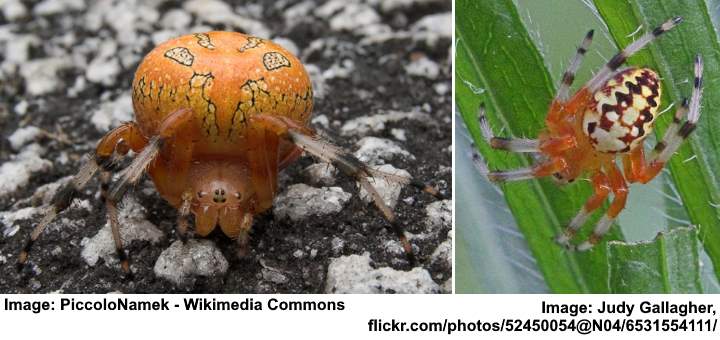
Marbled orb-weaver spider: female (left) and male (right)
The marbled orb-weaver is the most common type of orange spider. The small marbled orb-weaver spider has an easily identifiable rounded, bulbous brightly-colored orange abdomen with yellowish and black marbling. Other recognizable features of this common spider are its spiny orange, black, and white legs. The marbled orb-weaver spider measures 0.35” to 0.79” (9 – 20 mm).
Many species of marbled orb-weaver spiders have similar shades of orange color with relatively large rounded, egg-like abdomens and whitish spots. Some people say the orb-weaver bodies look like tiny orange pumpkins. This is why orange orb-weavers are also called pumpkin spiders.
Some marbled orb-weaver species have an orange body with black or brown patches. These patterns may be a light brown or tan with a black outline contrasting against the bright orange color. Other species have a pale orange, almost yellow abdomen with a large brown patch at the rear.
Another characteristic of an orange orb-weaver spider is the yellow to the burnt-orange color of the cephalothorax. Regardless of the abdominal coloring—orange, light red, yellow, or white—the spider’s cephalothorax is typically a dark orange color.
Many types of marbled orb-weavers also have orange legs that have white and black bands. Close-up pictures of the bright orange spiders also reveal tiny black or white spines on the legs.
Another type of orange marbled orb-weaver is the Araneus iviei. This orange spider with white spots has an identifiable ball-like orange abdomen with white markings on it. Up close, you’ll notice tiny white spines poking out from the dark orange legs and cephalothorax.
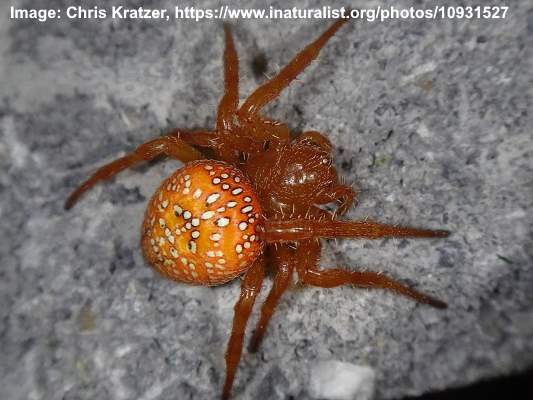
Araneus iviei is a type of orange marbled spider with white spots
Like many colorful spiders, there are distinguishing features between the male and female species. For example, if you notice an orange spider with an orange pumpkin-like abdomen, this is probably the female species. However, the male marbled orb-weaver spider has a pale yellow, egg-shaped abdomen with dark stripes in a zig-zag pattern. In addition, the male spider’s head and legs are dark orange and almost appear translucent.
Orange Male Spider Identification: The male marbled orb-weaver has an oval orange-yellow abdomen with black or dark brown patterns. It has a dark orange cephalothorax, and dark orange legs with black and white bands. The orange male spider measures 0.12” to 0.23” (3 – 6 mm).
Orange Female Spider Identification: The female marbled orb-weaver has a large, orange inflated bulbous abdomen with black or brown marble patterns and light yellowish patches. The orange female orb-weaver spiders measure 0.35” to 0.79” (9 – 20 mm).
Cross Orb-Weaver (Araneus diadematus)

Cross orb-weaver spider: female (left) and male (right)
The cross orb-weaver has a pale orange bulbous abdomen with creamy yellowish spots and patches forming a recognizable cross pattern. In addition, the colorful abdomen pattern has mottled markings giving the small spider a patchy appearance. The other identifying feature of this orange spider is its hairy legs. The adult female measures 0.26” to 0.79” (6.5 – 20 mm) long.
This cross orb-weaver gets its name from the segmented white stripe and patterns that form a cross. Other common names for this non-venomous spider include crowned orb-weaver, diadem spider, orangie, and European garden spider. Like the marbled orb-weaver, this species is also called the pumpkin spider.
Orange spider identification: The cross orb-weaver has an identifiable white cross-like marking on its bulbous pale orange abdomen.
Woodlouse Spider (Dysdera crocata)

Woodlouse spider is orange and brown spider with an elongated body
The woodlouse spider is an orange and brown spider with an elongated oval body, long legs, and large mouthparts. The spider’s cephalothorax is typically tawny orange to dark red with a shiny appearance. In contrast, the oval abdomen is a yellowish-brown or dark gray color.
Orange woodlouse spiders measure 0.43” to 0.6” (11 – 15 mm) long. The spider’s name comes from its diet, primarily of woodlice and pillbugs. It is also called the sowbug killer, pillbug hunter, and slater spider.
Orange spider identification: The woodlouse spider is identified by its shiny orange cephalothorax and legs and its brownish-gray oval body.
Triangular Spider (Arkys lancearius)
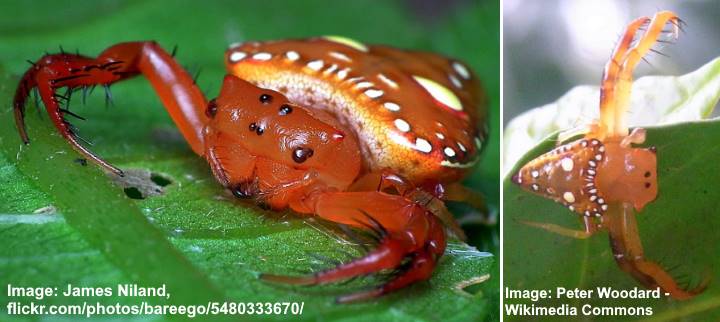
The small triangular spider has an unusual orange body shape with white spots and large two pairs of front legs
The triangular spider is an orange species of spider with white spots on its heart-shaped abdomen. This unusual spider has a pale orange or light red body with white dots around its three-sided abdomen. Pairs of larger white dots decorate the center. The tiny orange triangular spider measures 0.31” (8 mm).
Apart from its distinctive abdomen in the shape of a triangle, the spider’s other identifiable feature is its two pairs of large, outstretched forelegs. These are in contrast to the four lighter-colored, shorter, pale orange hindlegs.
Orange spider identification: The triangular spider has a unique heart-shaped abdomen with a translucent pale orange to reddish-orange color decorated with several white spots.
Jewel Spider (Gasteracantha quadrispinosa)
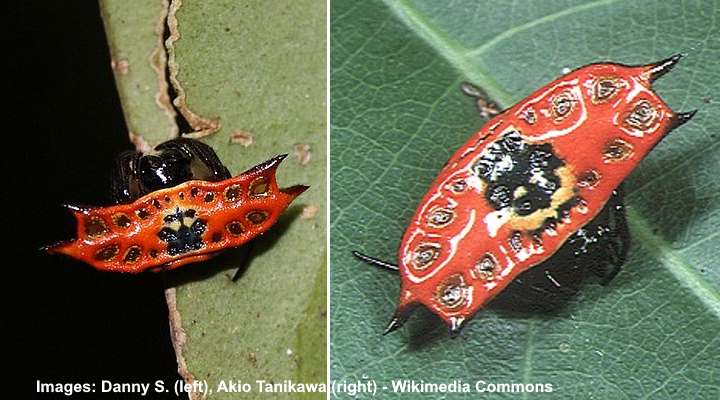
The jewel spider can be easily identified by its unique orangey-red body shape with black markings and four spines
The jewel spider is a strange-looking orange and black spider with a flat, black-spotted orange oblong abdomen. The distinguishing features of this spider are the four spines on the abdomen, distinctive black crown-like markings, and a shiny black cephalothorax. The jewel spider measures 0.19” – 0.23” (5 – 6 mm) wide.
The jewel spider is a type of orb-web spider that hangs in the center of the web to catch its prey. The spiny orb-weaver spider has a hard, shiny abdomen that ranges in orange, red, or yellow colors.
Orange spider identification: The jewel spider is easy to recognize due to its identifiable flat oblong orangey-red abdomen with black dots and a dark pattern at its spinneret.
Cardinal Jumper (Phidippus cardinalis)
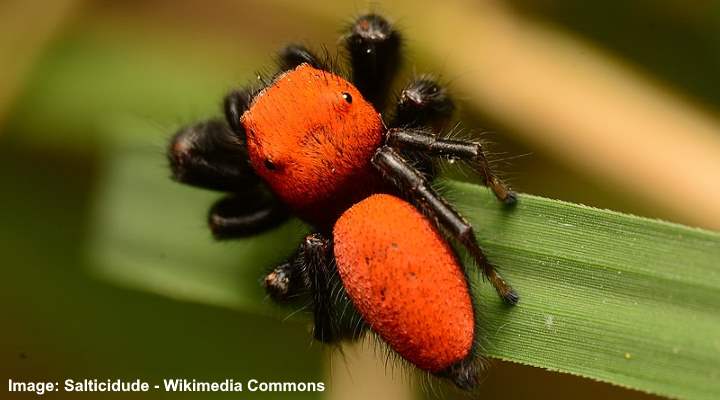
The cardinal jumper spider has an orange furry body with black hairy legs
The cardinal jumper is a tiny orange and black hairy spider with a fuzzy orange cephalothorax and abdomen. Identifying features of the cardinal jumper spider are its hairy body, jet black legs, bright orange coloring, and two prominent central eyes. This tiny spider measures 0.4” (10 mm) long.
The small black and orange cardinal jumper spider is classed as a type of wasp-mimicking spider. Cardinal jumper spiders mimic the appearance and habits of mutillid wasps, also called velvet ants. However, unlike the wasps, these spiders don’t sting. The spiders are also known for their ant-like behavior and bright orange coloring that helps to ward off predators like birds and other spiders.
Orange spider identification: The cardinal jumping spider is a furry orange and black spider with black, spiny legs, a row of four eyes, with the two central ones being most prominent.
Phidippus clarus
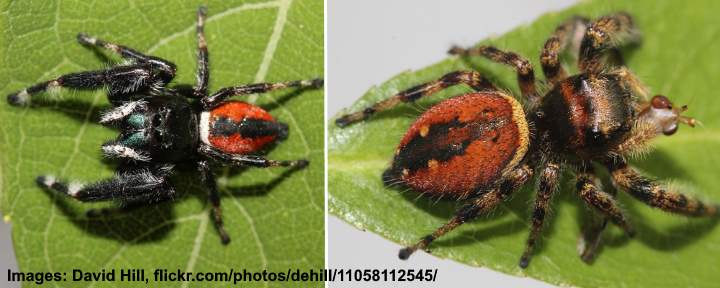
Phidippus clarus is a jumping spider with an orange abdomen and a black stripe. In the pictures: male (left) and female (right)
Phidippus clarus is a species of jumping spider with a distinctive orange abdomen and central black abdominal stripe. Identifying characteristics of this jumping male spider are its white abdominal band, black cephalothorax, and fuzzy black and white legs. The black and orange female adult spider measures 0.16” to 0.55” (4 – 14 mm) long.
Like many spider species, the female spider looks different from the male. The female species has a dark orange abdomen with a black or brown stripe and a light brown abdominal band. Also, the black cephalothorax has dark and pale orange bands across it.
Orange spider identification: The Phidippus clarus is identified by the thick black band running the length of its orange abdomen. The abdomen and cephalothorax are separated by a white or tan band.
Whitman’s Jumping Spider (Phidippus whitmani)

Whitman’s jumping spider is a dark orange and black spider with white hairs on its legs
The Phidippus whitmani is a hairy orange and black jumping spider with a deep orange, almost red furry abdomen and cephalothorax. The striking look of this reddish-orange spider is enhanced by its spiny legs covered in fine white hairs. The tiny spider also has a velvety appearance due to its fuzzy body.
The Phidippus whitmani measures 0.4” (10 mm) long.
Orange spider identification: The distinguishing characteristics of the Whitman’s jumping spider are its bold deep orange or red body and fuzzy grayish legs.
Triangle Orb-Weaver (Verrucosa arenata)
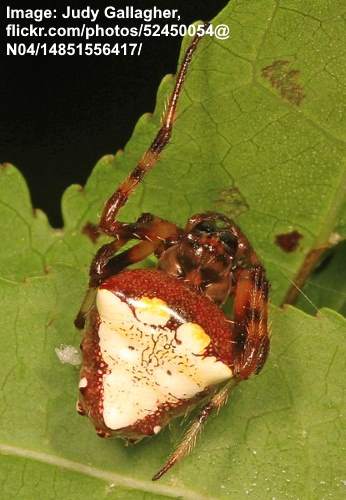
The triangle orb-weaver is easily identified by its orange and creamy white body shape
The triangle orb-weaver is an easily recognizable orange spider due to its three-sided abdomen. The unique looking orange spider has a rusty-red or dark orange triangular abdomen with a large cream-colored triangle. The spider’s cephalothorax and legs are brown with black markings. The triangle orb weaver is a medium-sized spider measuring 0.27” to 0.55” (7 – 14 mm) long.
Also called the arrowhead spider, the male orange and brown spider lacks the distinctive yellowish-white triangular mark on the abdomen. This native spider species is found in parks, gardens, and woodlands throughout North America.
Orange spider identification: The triangle orb-weaver is easy to identify due to its wedge-like triangle shape, dark orange and brown colors, and large creamy white abdominal marking.
Northern Crab Spider (Mecaphesa asperata)
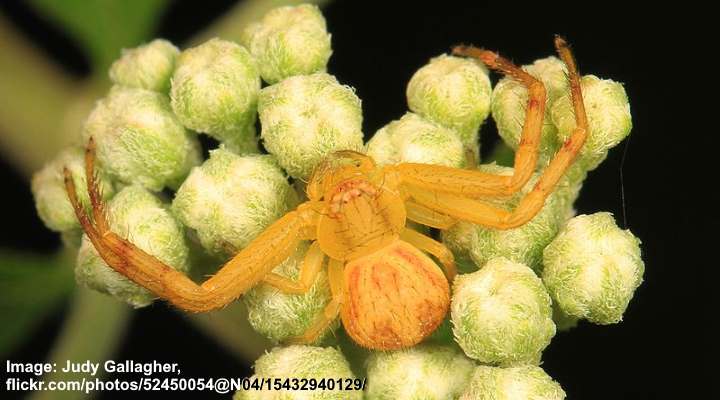
The northern crab spider has yellow body with orange markings and two pairs of front long legs
The northern crab spider is a tiny yellowish spider with orange markings on its legs, oval abdomen, and small cephalothorax. Identifying features of the crab spider include two pairs of long front legs, a brown to dark orange marking, and stiff black spines.
The female crab spider measures 0.23” (6 mm) long with a leg span of 0.5” (12 mm).
Orange spider identification: To identify the northern crab spider, look for the distinctive four large front legs, bulbous yellow and orange abdomen, and black spines sparsely covering its body and legs.
White-Banded Crab Spider (Misumenoides formosipes)
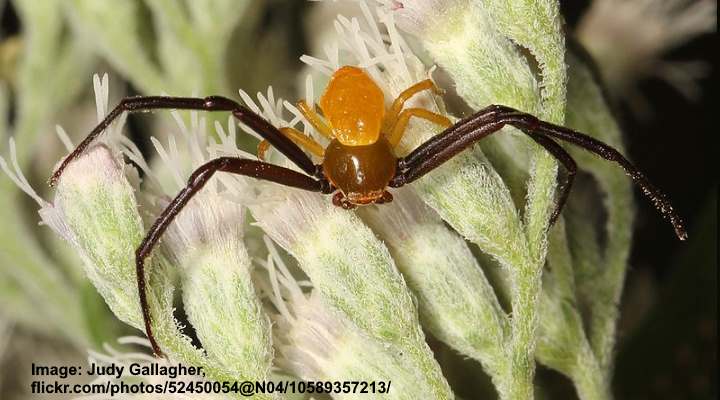
The tiny male white-banded crab spider has orange abdomen, two pairs of long dark brown front legs and two short pairs of orange rear legs
The male white-banded crab spider is an orange and brown spider with an amber-colored smooth abdomen, brown cephalothorax, and chocolate-brown legs. Like all crab spiders, the white-banded species has massive forelegs and significantly shorter rear legs. This male crab spider species measures 0.1” to 0.13″ (2.5 – 3.2 mm) long.
The common name “white-banded crab spider” comes from the female species. The female white-banded crab spider has a white, yellow, or light-brown triangular body with a V-shaped marking.
Orange spider identification: The male white-banded crab spider has a dark brown head, and golden amber abdomen. The easy way to identify the spider is that its hind leg colors match the abdomen, and the forelegs match the color of the cephalothorax.
Pale Orange Lynx Spider (Oxyopes javanus)
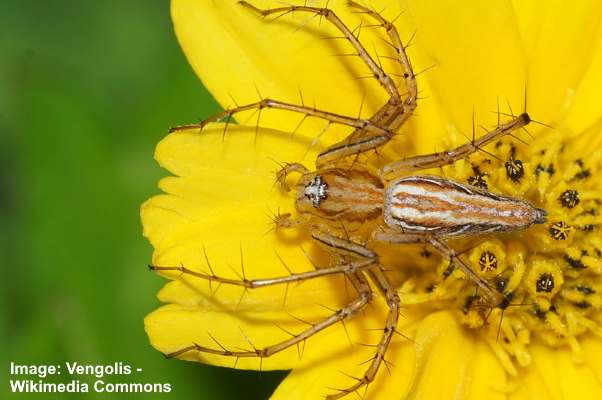
The lynx spider has elongated body with orange, white and brown stripes and spiny legs
The lynx spider is a pale orange arachnid with an elongated triangular abdomen with orange, white, and brown stripes. The spider’s tan-colored cephalothorax has two central orange stripes and darker brown bands along the edge. Close-up pictures of the lynx spider show that its legs are covered in long black spines.
The lynx spider measures 0.23” to 0.31” (6 – 8 mm) long, and the males are slightly smaller. This spider species is a type of hunting spider. It has six large eyes on the top of its head and two smaller eyes on the front.
Orange spider identification: The orange Oxyopes javanus is identified by its pale orange to yellow color, orange V-shaped markings, and spiky bristles on its legs.
Orange Lynx Spider (Oxyopes salticus)
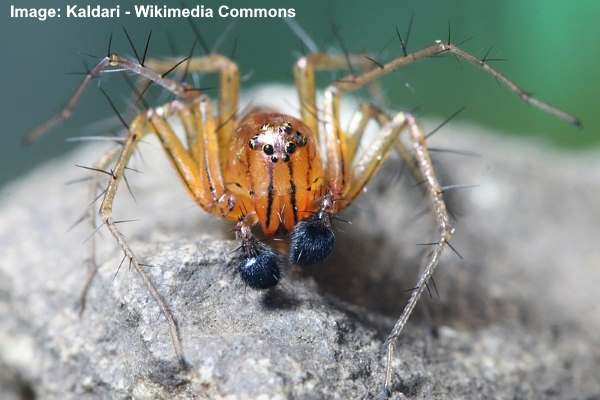
The tiny orange lynx spider has long spiny legs and two black furry palps
The Oxyopes salticus is an orange spider with a large orange cephalothorax, a small triangular abdomen, and long spiny legs. The characteristic features of this tiny orange spider are its eight eyes arranged in a hexagonal pattern. In addition, the little spider has two black furry palps at its front.
The adult body of the Oxyopes salticus female spider measures 0.23” (6 mm), and the males are around 0.19” (5 mm) long. However, their long leg span makes the spiders appear larger.
Orange spider identification: The identifiable features of the orange lynx spider are its orangey head with two black stripes, eight black eyes, and two black palps in front of its mouthparts.
Black and Orange Dwarf Spider (Hypselistes florens)
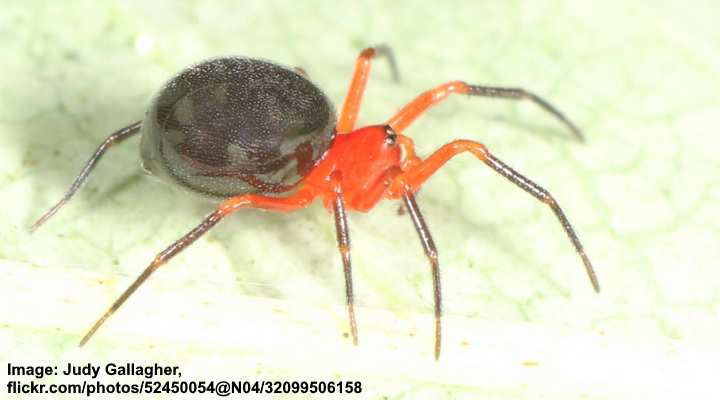
The dwarf spider is identified by an orange-reddish head and rounded black abdomen
Hypselistes florens is a type of dwarf spider with a bright orange cephalothorax and bulbous shiny black abdomen. This orange and black spider also has recognizable spindly orange legs with broad black bands on them. Up close, you’ll notice that the spider’s eight eyes are arranged in an oval pattern.
The tiny orange spider only measures 0.11” (3 mm) long, and the adult male species is a minute 0.07” (1.8 mm) long.
Orange spider identification: The Hypselistes florens is identified easily by its brightly-colored orange cephalothorax and legs and jet-black ball-like swollen abdomen.
Blacktailed Red Sheetweaver (Florinda coccinea)

The tiny blacktailed red sheetweaver has reddish body, slender black legs and black tail-end
The blacktailed red sheetweaver is a tiny dark orange spider with an elongated oval body and black tip at its rear. The little spider has a rounded cephalothorax and a tear-shaped abdomen. Unlike other types of dwarf spiders, the body color of this species is a single burnt-orange color.
The blacktailed red sheetweaver spider has greenish legs with tiny black spines. The orange spider measures 0.16” (4 mm) long.
Orange spider identification: The identifiable characteristics of the blacktailed red sheetweaver are a dark-orange, almost red body, greenish-black legs, and a black protrusion at the end of the abdomen.
